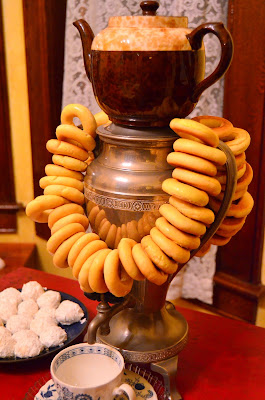Russia. Land of snow, vodka, and depressing literature. At least, that's what I was thinking going into this week's study. After a bit of reading, I remembered there's actually a lot to like about the country and culture. So many fun stories, like The Fool of the World and the Flying Ship (more on that in another post), wonderful music (as I write this, Annie is in bed singing themes from Peter and the Wolf to her sisters), and matryoshkas! Also, the food isn't all meat, potatoes, and cabbage. Granted, a lot of it is. In fact, one of the common Russian dishes I found is Golubtsi, which is the same as the sarmale we had last week. Seeking a lighter meal, I came across this picture and knew exactly what we'd have for our weekly meal: a Russian tea!
My sister was visiting this weekend, which made our Russian tea party that much more fun. She brought our grandma's old teapot, which we used with our samovar (Russian tea urn - literally "self boiler") to serve.
I have an antique coffee urn which is very similar to a Russian samovar, so we had fun drinking tea Russian style. We used this recipe for tea, decaf, and with a fresh orange. We brewed the tea in a concentrated form in the teapot, and then diluted in our teacups with hot water from the samovar. The teapot sits on top of the samovar to stay warm, although we took ours down soon after taking the pictures so the kids wouldn't knock it off and break our grandma's teapot. That would be a tragic end to the story. The tea was delicious, and I'm not a big black tea drinker. It was almost fruity and sweet enough that the girls liked it, but they weren't entirely sold.
This beet salad was the centerpiece of the table: beautiful, and very interesting with the crispy fried potatoes combined with the dramatic color of the beets. It's definitely going to make a repeat appearance at our dinner table, although next time I'm only going to mix together as much as we can eat in one meal. The fried potatoes get completely lost in the salad when you're eating the leftovers.
The real star of the show was the tea in the samovar, and the tea cakes. I made Collin's favorite Russian tea cakes (the kind with powdered sugar and walnuts), and a huge string of sushki. The sushki are kind of a cross between a cracker and a cookie - very slightly sweet, and crunchy like Italian breadsticks (grissini). Both tea cakes are very dry, and not amazing on their own, but the perfect accompaniment for a hot cup of tea.
Learning about Russian tea and samovars was one of my favorite parts of geography this week. I bought our samovar a couple years ago because we needed a way to serve hot water to large groups of people for evening parties. Our tea kettle was running out of water too quickly, and an air pot was kind of boring. We bought this samovar off Ebay to have something more festive, but I didn't learn much about the way Russians use them until this week. This video on brewing tea Russian-style was especially enlightening. Apparently, before electric samovars became common, the water was boiled by a lighting a fire in a pipe inside the samovar. The fire was often fueled with pine cones, and infused the tea with a delicious outdoorsy flavor unique to old-style samovars. Mine is electric, so missing that unique smoky flavor, but it was still fun to drink cup after cup of tea Russian style, and imagine we were fortifying ourselves for the long, cold winter ahead.






No comments:
Post a Comment